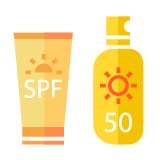
By
Rob Boyle
October 10, 2024
Updated
October 10, 2024

What is skin cancer and how serious is it?
Skin cancer occurs when skin cells are damaged and abnormal skin cells grow, often caused by ultraviolet (UV) radiation from sunshine. The most common types of skin cancer include melanoma, basal cell cancer, and squamous cell carcinoma.
Skin cancer is the most common cancer in the United States. In fact, more skin cancers are diagnosed in the US each year than all other cancers combined. The number of skin cancer cases has been going up over the past few decades.
Most skin cancers are caused by too much exposure to ultraviolet (UV) rays. Most of this exposure comes from the sun, but some may come from man-made sources, such as indoor tanning beds and sun lamps. The good news is that you can do a lot to protect yourself and your family from UV rays. Below you will find some tips from the American Cancer Society on how to protect yourself from damaging UV rays.
Seek shade
 A very important way to limit your exposure to UV light is to avoid being outdoors in direct sunlight for too long. This is particularly important between the hours of 10:00 AM and 4:00 PM, when UV light is strongest. Be especially careful on the beach or even in areas with snow. Sand, water and snow reflect sunlight, increasing the amount of UV radiation exposed to you. UV rays can also reach below the water's surface, so you can still get a burn even if you're in the water and feeling cool.
A very important way to limit your exposure to UV light is to avoid being outdoors in direct sunlight for too long. This is particularly important between the hours of 10:00 AM and 4:00 PM, when UV light is strongest. Be especially careful on the beach or even in areas with snow. Sand, water and snow reflect sunlight, increasing the amount of UV radiation exposed to you. UV rays can also reach below the water's surface, so you can still get a burn even if you're in the water and feeling cool.
Protect your skin with clothing
 When you are out in the sun, wear clothing to cover your skin. Clothes provide different levels of UV protection. Long-sleeved shirts, long pants, or long skirts cover the most skin and are the most protective.
When you are out in the sun, wear clothing to cover your skin. Clothes provide different levels of UV protection. Long-sleeved shirts, long pants, or long skirts cover the most skin and are the most protective.
Dark colors generally provide more protection than light colors. A tightly woven fabric protects better than loosely woven clothing. Dry fabric is generally more protective than wet fabric.
Be aware that covering up doesn't block out all UV rays. If you can see light through a fabric, UV rays can get through, too.
Use sunscreen
 Sunscreen is a product that you put on your skin to protect it from the sun's UV rays, but it is important to know that sunscreen is just a filter. It does not block all UV rays. Sunscreen should not be used as a way to prolong your time in the sun. Even with proper sunscreen use, some UV rays still get through. Sunscreen should not be your first line of defense. Consider sunscreen as one part of your skin cancer protection plan, especially if staying in the shade and wearing protective clothing aren't available as your first options.
Sunscreen is a product that you put on your skin to protect it from the sun's UV rays, but it is important to know that sunscreen is just a filter. It does not block all UV rays. Sunscreen should not be used as a way to prolong your time in the sun. Even with proper sunscreen use, some UV rays still get through. Sunscreen should not be your first line of defense. Consider sunscreen as one part of your skin cancer protection plan, especially if staying in the shade and wearing protective clothing aren't available as your first options.
Sunscreens labeled with a sun protection factor or SPF number indicate the amount of protection against UV rays. For example, the standard SPF 15 sunscreen filters out about 93% of UVB rays. Some SPF's as high as 100+ are available. Higher numbers mean more protection. Below is a rough guide:
- SPF 15: 93%
- SPF 30: 97%
- SPF 50: 98%
- SPF 100: 99%
The higher you go, the smaller the difference becomes. No sunscreen protects you completely. Sunscreens with an SPF lower than 15 must now include a warning on the label stating that the product has been shown to only help prevent sunburn, not skin cancer or early skin aging.
Wear sunglasses that block UV rays
 UV-blocking sunglasses are important for protecting the delicate skin around the eyes, as well as the eyes themselves.
UV-blocking sunglasses are important for protecting the delicate skin around the eyes, as well as the eyes themselves.
Research has shown that long hours in the sun without protecting your eyes increase your chances of developing certain eye diseases.
The ideal sunglasses should block 99% to 100% of UVA and UVB rays. Before you buy, check the label to make sure they do.
Labels that say "UV absorption up to 400 nm" or "Meets ANSI UV Requirements" means the glasses block at least 99% of UV rays. Those labeled "cosmetic" block about 70% of UV rays. If there's no label, assume the sunglasses don't provide any UV protection.
Darker glasses are not necessarily better because UV protection comes from an invisible chemical in or applied to the lenses, not from the color or darkness of the lenses. Look for an ANSI label.
Avoid tanning beds and sun lamps
 Many people believe the UV rays of tanning beds are harmless. This is not true. Tanning lamps give out UVA and usually UVB rays as well. Both UVA and UVB rays can cause long-term skin damage and can contribute to skin cancer. Tanning bed use has been linked with an increased risk of melanoma, especially if it's started before a person is 30 years old. Most skin doctors and health organizations do not recommend the use of tanning beds and sun lamps.
Many people believe the UV rays of tanning beds are harmless. This is not true. Tanning lamps give out UVA and usually UVB rays as well. Both UVA and UVB rays can cause long-term skin damage and can contribute to skin cancer. Tanning bed use has been linked with an increased risk of melanoma, especially if it's started before a person is 30 years old. Most skin doctors and health organizations do not recommend the use of tanning beds and sun lamps.
